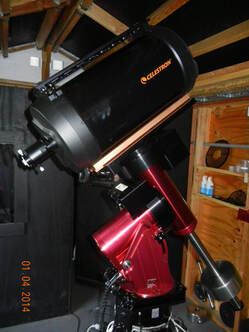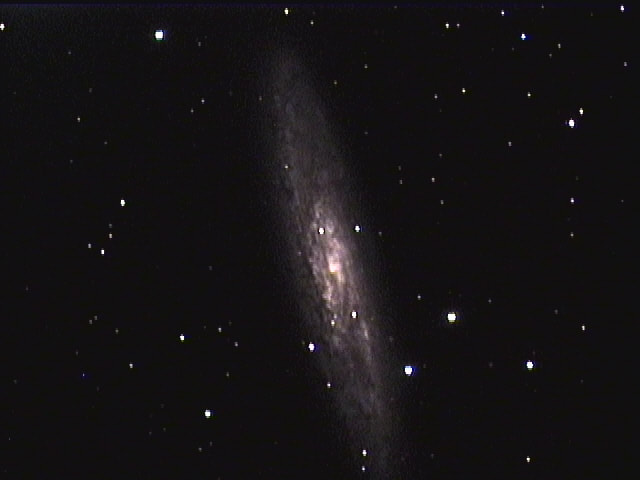 My first telescope was a 60mm Unitron refactor which I bought with money saved from my paper route when I was about 14 years old. At f/15 this refractor was designed for solar, lunar and planetary work which I did visually from my heavily light polluted back yard in Pittsburgh, PA. Dreams of deep space objects and trying my hand at astrophotography would have to wait many decades until I purchased my second scope, a 9.25" Celestron SCT. The SCT is a versatile telescope design which can be used for solar, lunar and planetary work at its native f/10 or higher with a barlow, or for deep space objects with a focal reducer at f/6.3 and lower. My 9.25" was used primarily for Camera Assisted Viewing (CAV),or EAA. It has good optics, is light weight, provides excellent aperture/cost and mine seemed not to suffer much from mirror flop or mirror shift. I have posted many images on this web site taken with the 9.25" and a variety of video cameras. (Keep in mind that CA or EAA is not about true astrophotography but is focused on real time viewing with a camera. It is understood that images captured with a video camera will never compete with those captured with a true astrophotography camera. Instead, the images serve as a "postcard" of each DSO visited and viewed in much greater detail with the camera in real time than what would be visible with an eyepiece only).  It only took a couple of years for me to succumb to "aperture fever" and order a second SCT, the Celestron 14" Edge with Hyperstar. The C14 obviously has a much larger aperture than the C9.25 which allows it to collect ~2.3X as much light. This allowed me to get much more detail and much higher magnification when viewing and imaging deep space objects. And with Hyperstar, which my particular C9.25 does not have, the C14 can achieve a focal ratio of 1.9 providing a very fast optical system which is ideal for CAV. See the photo below of the Sculptor Galaxy NGC253 taken with a Mallincam Xtreme video camera with the C14 Hyperstar at f/1.9. The exposure time was a mere 14sec, yet the image shows amazing detail for such a short time due to the very fast optics and the high sensitivity of the sensor in the Xtreme. With performance like this I referred to the C14 as my "Big Gun". Initially I planned to use the C14 only in my home observatory since it is nearly twice the weight of the C9.25. But, darker skies called and I began taking the C14 with me to my typical star parties, GSSP and CalStar. The "Big Gun" has been my companion at nearly every one of these star parties since 2012. As my interest in CAV led me to more traditional astrophotography with CMOS cameras like the ASI 224MC and 1600MC, the C14 was the natural choice for an OTA. As I mentioned above, it's ability to go from f/11 (the C14 Edge is native f/11 instead of f/10) to f/7 withe the very expensive Edge focal reducer and to f/1.9 with the even more expensive Hyperstar adapter, makes the C14 a very versatile scope for astrophotography. Below is one of my first attempts at traditional astrophotography using the C14 in hyperstar mode with an ASI1600MC. The image is a stack of 116 x 30sec subs with dark frame subtraction and a stretch of the data to obtain the final image. At 46 lbs not counting any extra mounting plates, the C14 is a challenge to mount and de-mount without assistance. The fact that most of the weight is at the back end makes it even more difficult to maneuver into place. With age and after surgery on each of my shoulders, it was clear that my " Big Gun" needed a new home. While sorry to see it go, I was lucky to find a very experienced astrophotographer in my local astronomy club who could not only handle this massive scope physically, but could also put it to excellent use. While I still have my C9.25 I was not ready to completely give up on large apertures. So I immediately used the proceeds to purchase a C11 Edge which is only slightly heavier than my C9.25. I hope to be able to use this smaller, yet fairly large scope for many years to come as I work on my attempts to master traditional astrophotography. I expect to post images with this new scope, on this web site in the near future. If you are interested in the Celestron 14" SCT you can find it and the accessories I used here: Celestron 14" Edge - if you can handle a telescope this size you will be amazed by what it can do. Hyperstar 14" - this turns your SCT into a Schmidt camera at f/1.9. Super fast and wide field 14" Hyperstar Metallic Dew Shield- I kept this on overnight with the Hyperstar attached Telrad Reflex Finder - I love this thing. So simple. I never use my 50mm finder As an OPT Affiliate I can earn from qualifying purchases through my site with no additional cost to you. This helps to defray the cost of this website.
0 Comments
Leave a Reply. |
Categories
All
Archives
January 2024
|


 RSS Feed
RSS Feed